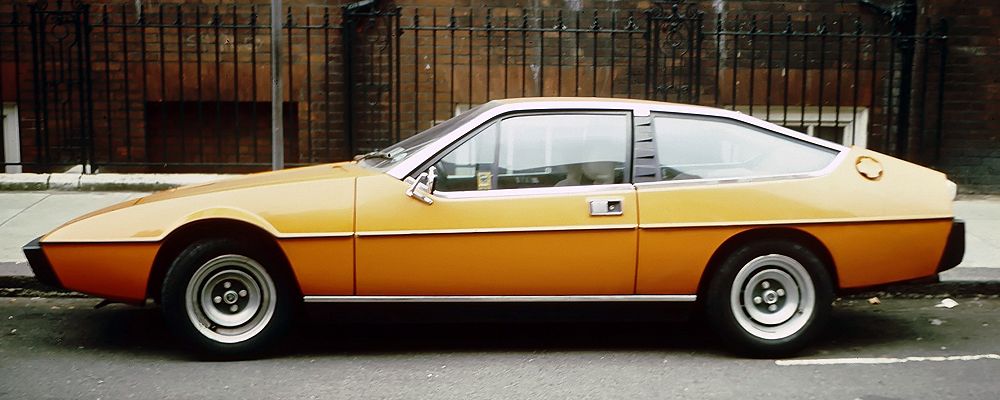Description
The Lotus Eclat was introduced in 1975 as a companion model to the second-generation Elite and shared much of its mechanical and structural design. Whereas the Elite was styled as a distinctive shooting-brake hatchback, the Eclat adopted a more conventional fastback coupé shape, with a sloping rear deck and separate boot rather than a full rear hatch. This gave it a slightly lighter and more aerodynamic profile, appealing to buyers who wanted Lotus handling and engineering but with a sportier and less practical body design. Both models were developed under the supervision of Colin Chapman and designed by Oliver Winterbottom, featuring the same glass-reinforced plastic bodywork mounted on a steel backbone chassis, a layout that had become a Lotus trademark.
The Eclat used the same Lotus 907 engine as the Elite, an all-aluminium 2.0-litre twin-cam sixteen-valve four-cylinder unit producing around 155 horsepower. Power was delivered through a five-speed manual gearbox to the rear wheels, though some versions were also available with a three-speed automatic transmission. The Eclat retained Lotus’s hallmark features of fully independent suspension, rack-and-pinion steering, and disc brakes at both ends, giving it the agility and composure expected of the brand. The car’s low centre of gravity and balanced weight distribution made it one of the best-handling four-seater sports cars of its era, with a combination of cornering grip, steering precision, and ride comfort that few rivals could match.
In terms of performance, the early Eclat was capable of reaching 60 mph in around 7.8 seconds, with a top speed close to 125 mph. The lightweight fibreglass construction contributed to both its speed and efficiency, allowing the car to deliver lively acceleration despite its modest engine size. Reviewers at the time praised the car’s dynamics, particularly its steering feedback and composure on twisty roads. They also noted that the Eclat felt more refined and better balanced than many contemporary British sports cars, offering a blend of performance and practicality rare for its class.
The Eclat’s interior was designed to offer genuine four-seat accommodation, with a well-trimmed cabin that was more luxurious than earlier Lotus models. It featured comfortable bucket seats, quality carpeting, and a driver-oriented dashboard with comprehensive instrumentation. Air conditioning, power steering, and a stereo cassette system were optional or standard depending on the variant. The boot, although smaller than that of the Elite, provided useful luggage space, making the Eclat suitable for touring. The car was offered in a range of trims, including the Eclat 520, 521, 522, and 523, each denoting different levels of equipment such as air conditioning, power steering, and transmission options.
In 1980, Lotus introduced the Eclat S 2.2, which featured the updated 2174 cc Type 912 engine. This engine delivered improved torque and mid-range flexibility, addressing the criticisms levelled at the earlier 2.0-litre version. The Eclat S 2.2 also benefitted from refinements to the suspension, interior, and build quality. It was the most accomplished iteration of the model and would form the direct basis for the later Lotus Excel, introduced in 1982, which incorporated further improvements and a closer partnership with Toyota for components and production reliability.
The Eclat was always a driver’s car first and foremost. Its combination of sharp handling, supple ride, and excellent visibility made it a rewarding car to use both on winding roads and long journeys. However, like the Elite, the Eclat struggled to find a large market. Its high price, limited brand recognition outside the sports-car niche, and some early reliability concerns all restricted sales. Nevertheless, it showcased Lotus’s ambition during the 1970s to create a line of sophisticated, four-seat sports cars that could stand alongside grand tourers from Jaguar, BMW, and Porsche while maintaining a unique engineering philosophy centred on lightness and precision.
Today, the Lotus Eclat holds an interesting place in the brand’s history. It represents the transitional phase between Lotus’s early lightweight sports cars and the more modern, refined GTs that followed. Collectors appreciate it for its rarity, handling ability, and distinctive styling, which has aged into a symbol of 1970s British automotive design. The Eclat’s legacy lives on most directly in the Lotus Excel, which carried forward its basic architecture into the 1980s, but the Eclat itself remains a true expression of Lotus engineering — light, agile, and unpretentious, yet imbued with an elegance that set it apart from more conventional sports cars of its day.

